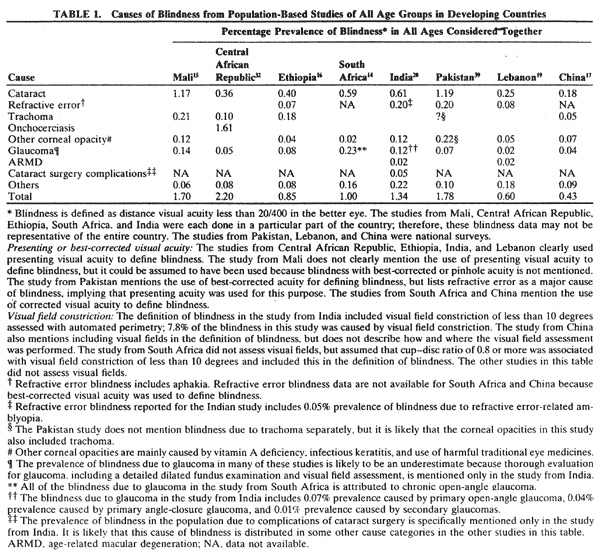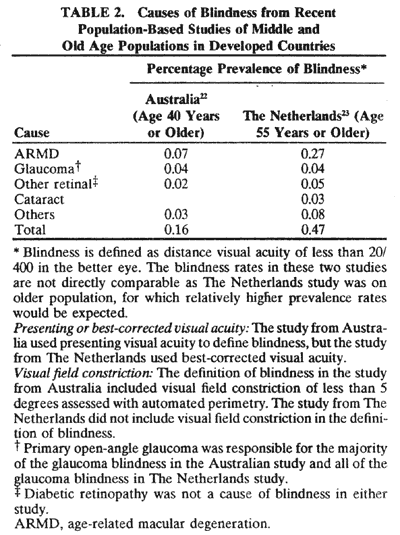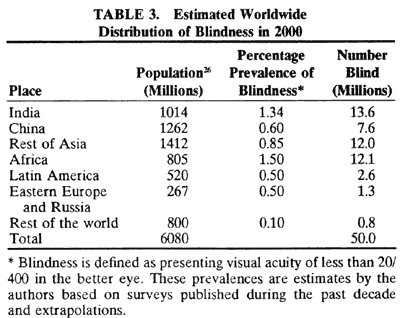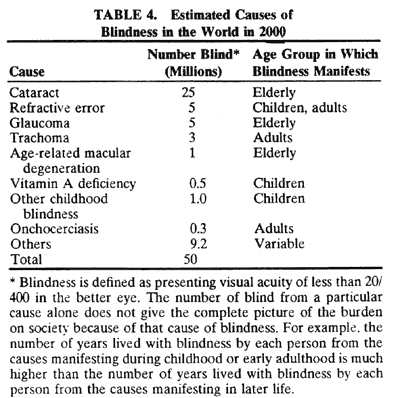1. Programme for the Prevention of Blindness and Deafness, World Health Organization: Global
Initiative for the Elimination of Avoidable Blindness. Geneva: WHO, 1997 2. International Statistical Classification of Diseases and Related Health
Problems, 10th rev. Geneva: WHO, 1992 3. Foster A: Vision 2020—The Right to Sight. IAPB News 25:3–4, 2000 4. Thylefors B: A global initiative for the elimination of avoidable blindness. Am
J Ophthalmol 125:90–93, 1998 (editorial) 5. Pararajasegaram R: Vision 2020—The Right to Sight: From strategies
to action. Am J Ophthalmol 128:359–360, 1999 (editorial) 6. Dandona R, Dandona L: Refractive error blindness. Bull WHO 79:237–243, 2001 7. Tielsch JM, Sommer A, Witt K et al: Blindness and visual impairment in an American urban population: The Baltimore
Eye Survey. Arch Ophthalmol 108:286–290, 1990 8. Taylor HR, Livingston PM, Stanislavsky YL et al: Visual impairment in Australia: Distance visual acuity, near vision, and
visual field findings of the Melbourne Visual Impairment Project. Am J Ophthalmol 123:328–337, 1997 9. West SK, Munoz B, Rubin GS et al: Function and visual impairment in a population-based study of older adults: The
SEE Project. Invest Ophthalmol Vis Sci 38:72–78, 1997 10. Reidy A, Minassian C, Vafidis G et al: Prevalence of serious eye disease and visual impairment in a north London
population: Population based cross sectional study. BMJ 316:1643–1646, 1998 11. Dandona L, Dandona R, Naduvilath TJ et al: Is current eye-care-policy focus almost exclusively on cataract adequate
to deal with blindness in India? Lancet 351:1312–1316, 1998 12. Murdoch IE, Jones BR, Cousens S et al: Visual field constriction as a cause of blindness or visual impairment. Bull World Health Organ 75:141–146, 1997 13. Whitfield R, Schwab L, Ross-Degnan D et al: Blindness and eye disease in Kenya: Ocular status survey results from the
Kenya Rural Blindness Prevention Project. Br J Ophthalmol 74:333–340, 1990 14. Cook CD, Knight SE, Crofton-Briggs I: Prevalence and causes of low vision and blindness in northern KwaZulu.S Afr Med J 83:590–593, 1993 15. Kortlang C, Koster JCA, Coulibaly S et al: Prevalence of blindness and visual impairment in the region of Segou, Mali: A
baseline survey for a primary eye care programme. Trop Med Int Health 1:314–319, 1996 16. Zerihun N, Mabey D: Blindness and low vision in Jimma zone, Ethiopia: Results of a population-based
survey. Ophthalmic Epidemiol 4:19–26, 1997 17. Zhang SY, Zou LH, Gao YQ et al: National epidemiological survey of blindness and low vision in China. Chin Med J 105:603–608, 1992 18. Negrel AD, Minassian DC, Sayek F: Blindness and low vision in southeast Turkey. Ophthalmic Epidemiol 3:127–134, 1996 19. Mansour AM, Kassak K, Chaya M et al: National survey of blindness and low vision in Lebanon. Br J Ophthalmol 81:905–906, 1997 20. Dandona L, Dandona R, Srinivas M et al: Blindness in the Indian state of Andhra Pradesh. Invest Ophthalmol Vis Sci 42:908–916, 2001 21. Attebo K, Mitchell P, Smith W: Visual acuity and the causes of visual loss in Australia: The Blue Mountain
Eye Study. Ophthalmology 103:357–364, 1996 22. VanNewkirk MR, Weih L, McCarty CA et al: The cause-specific prevalence of bilateral visual impairment in Victoria, Australia: The
Visual Impairment Project. Ophthalmology 108:960–967, 2001 23. Klaver CCW, Wolfs RCW, Vingerling JR et al: Age-specific prevalence and causes of blindness and visual impairment in
an older population: The Rotterdam Study. Arch Ophthalmol 116:653–658, 1998 24. Klein R, Klein BEK, Linton KLP et al: The Beaver Dam Eye Study: visual acuity. Ophthalmology 98:1310–1315, 1991 25. Thylefors B, Negrel AD, Pararajasegaram R et al: Global data on blindness. Bull World Health Organ 73:115–121, 1995 26. US Census Bureau. International Data Base: http:/www.census.gov (accessed
September 2000) 27. Dandona L, Williams JD, Williams BC et al: Population-based assessment of childhood blindness in southern India. Arch Ophthalmol 116:545–546, 1998 28. Rahi JS, Sripathi S, Gilbert CE et al: Childhood blindness in India: causes in 1318 blind school students in nine
states. Eye 9:545–550, 1995 29. Gilbert C, Foster A: Epidemiology of childhood blindness. In Moore A (ed): Fundamentals
of Clinical Ophthalmology: Paediatric Ophthalmology. London: BMJ
Books, 2000 30. Gilbert CE, Anderton L, Dandona L et al: Prevalence of visual impairment in children: A review of available data. Ophthalmic Epidemiol 6:73–82, 1999 31. Gilbert CE, Rahi J, Eckstein M et al: Retinopathy of prematurity in middle-income countries. Lancet 350:12–14, 1997 32. Schwartz EC, Huss R, Hopkins A et al: Blindness and visual impairment in a region endemic for onchocerciasis
in the Central African Republic. Br J Ophthalmol 81:443–447, 1997 33. Sommer A, Tielsch JM, Katz J et al: Racial differences in the cause-specific prevalence of blindness in East
Baltimore. N Engl J Med 325:1412–1417, 1991 34. Baasanhu J, Johnson GJ, Burendei G et al: Prevalence and causes of blindness and visual impairment in Mongolia: A
survey of population aged 40 years and older. Bull WHO 72:771–776, 1994 35. Taylor HR, Katala S, Munoz B et al: Increase in mortality associated with blindness in rural Africa. Bull World Health Organ 69:335–338, 1991 36. Abou-Gareeb I, Lewallen S, Bassett K et al: Gender and blindness: A meta-analysis of population-based prevalence surveys. Ophthalmic Epidemiol 8:39–56, 2001 37. Fletcher AE, Donoghue M, Devavaram J et al: Low uptake of eye services in rural India: A challenge for programs of
blindness prevention. Arch Ophthalmol 117:1393–1399, 1999 38. Ranson MK, Evans TG: The global burden of trachomatous visual impairment. I. Assessing prevalence.Int Ophthalmol 19:261–270, 1995-1996 39. Memon MS: Prevalence and causes of blindness in Pakistan. J Pak Med Assoc 42:196–198, 1992 40. Tielsch JM, Sommer A, Katz J et al: Socioeconomic status and visual impairment among urban Americans. Arch Ophthalmol 109:637–641, 1991 41. Foster PJ, Oen FT, Machin D et al: The prevalence of glaucoma in Chinese residents of Singapore: A cross-sectional
population survey of the Tanjong Pagar district. Arch Ophthalmol 118:1105–1111, 2000 42. Foster PJ, Baasanhu J, Alsbirk PH et al: Glaucoma in Mongolia: A population-based survey in Hovsgol province, Northern
Mongolia. Arch Ophthalmol 114:1235–1241, 1996 43. Dandona L, Dandona R, Mandal P et al: Angle-closure glaucoma in an urban population in southern India: The Andhra
Pradesh Eye Disease Study. Ophthalmology 107:1710–1716, 2000 44. Tielsch JM, Sommer A, Katz J et al: Racial variations in the prevalence of primary open-angle glaucoma. JAMA 266:369–374, 1991 45. Leske MC, Connell AMS, Schachat AP et al: The Barbados Eye Study: Prevalence of open angle glaucoma. Arch Ophthalmol 112:821–829, 1994 46. Buhrmann RR, Quigley HA, Barron Y et al: Prevalence of glaucoma in a rural East African population. Invest Ophthalmol Vis Sci 41:40–48, 2000 47. Faal H, Minassian DC, Dolin PJ et al: Evaluation of a national eye care programme: A re-survey after 10 years. Br J Ophthalmol 84:948–951, 2000 48. Vassileva P, Gieser SC, Vitale S et al: Blindness and visual impairment in Western Bulgaria. Ophthalmic Epidemiol 3:143–149, 1996 49. Awan HR, Ihsan T: Prevalence of visual impairment and eye diseases in Afghan refugees in
Pakistan. East Mediterr Health J 4:560–566, 1998 50. Dana MR, Tielsch JM, Enger C et al: Visual impairment in a rural Appalachian community: Prevalence and causes. JAMA 264:2400–2405, 1990 51. Stocks NP, Newland H, Hiller J: The epidemiology of blindness and trachoma in the Anangu Pitjantjatjara
of South Australia. Med J Aust 160:751–756, 1994 52. Al-Faran MF, Al-Rajhi AA, Al-Omar OM et al: Prevalence and causes of visual impairment and blindness in the South Western
region of Saudi Arabia. Int Ophthalmol 17:161–165, 1993 53. Pokharel GP, Selvaraj S, Ellwein LB: Visual function and quality of life outcomes among cataract operated and
unoperated blind populations in Nepal. Br J Ophthalmol 82:606–610, 1998 54. Zhao J, Sui R, Jia L et al: Visual acuity and quality of life outcomes in patients with cataract in
Shunyi county, China. Am J Ophthalmol 126:515–523, 1998 55. He M, Xu J, Li S et al: Visual acuity and quality of life in patients with cataract in Doumen County, China. Ophthalmology 106:1069–1615, 1999 56. Dandona L, Dandona R, Naduvilath TJ et al: Population-based assessment of the outcome of cataract surgery in an urban
population in southern India. Am J Ophthalmol 127:650–658, 1999 57. Limburg H, Foster A, Vaidyanathan K et al: Monitoring visual acuity outcome of cataract surgery in India. Bull WHO 77:455–460, 1999 58. Singh AJ, Garner P, Floyd K: Cost-effectiveness of public-funded options for cataract surgery in Mysore, India. Lancet 355:180–184, 2000 59. Rapoza PA, West SK, Katala SJ et al: Prevalence and causes of vision loss in central Tanzania. Int Ophthalmol 15:123–129, 1991 60. Foster A: Who will operate on Africa's 3 million curably blind people? Lancet 337:1267–1269, 1991 61. Dandona L, Dandona R, Shamanna BR et al: A model for high-quality sustainable
eye-care services in rural India. In Pararajasegaram R, Rao GN (eds): World
Blindness and Its Prevention. Vol 6. Hyderabad: International
Agency for the Prevention of Blindness, 2001 62. Dandona L: Blindness control in India: Beyond anachronism. Lancet 356:S25, | 






